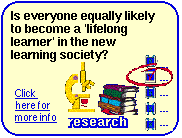New Ways To
Learn
5. Developing a learning community
The traditional process of learning belongs in an
institution designed for the purpose. However, we think that
the natural home of the new process described here is a
learning community, which brings together all that is
necessary to create and sustain a learning culture. This
community does not have to be based on an institution or
campus.
Communities may take many forms: pupils, parents and
teachers in compulsory schooling; professions or trades
within an industry; geographically-based communities; or
national or global communities of interest.
We see cases both of existing institutions expanding
beyond their walls (in some cases worldwide), and of
entirely new communities emerging that would not have been
possible even five or ten years ago. It is clear that there
will be many variants: new learning will consist of
variations on a common set of themes, drawn from a
repertoire that no longer relies on the classroom to supply
its basic structure.
Supporting lifelong
learning
Our research suggests that the most effective way to
support lifelong learning will be to stimulate the
development of learning communities. This is likely to give
a better return on investment than measures at the
individual or course level.

For many people, learning is only prompted by desperation
or disaster. The environment in which they live does not
support or encourage learning, so that an extreme event -
such as redundancy - is necessary for people to put
themselves in a situation where learning can take place.
Exceptional individuals (as shown by some of our examples)
learn anyway; but many are not prompted to make the
effort.
The new process offers hope, for
example by allowing individuals to participate
electronically in communities which support learning, even
where their immediate environment does not. But a different
set of barriers must be overcome to enable this. The two key
problems we have identified are:
- Access to technology on acceptable terms
- Systematic support for innovation in further
education.

Systematic support exists in schools and in higher
education, but to a much lesser extent in further education,
where arguably it could do most good. Innovation is clearly
needed to break the pattern of a resistant proportion of the
population - up to 30% in some areas - which sidesteps all
opportunities for post-compulsory learning. The size of this
rump has remained stubbornly constant for many years.
Creating learning communities
How to create a learning institution is well understood.
All the necessary elements can be controlled by a single
body. There is less experience of creating a learning
community. It cannot be directly controlled, although
the right actions can start a process which becomes at least
partly self-sustaining.
Figure 3 shows a combination of measures which could
achieve innovation of this kind, on a scale adequate to the
problem.

Figure 3: Building Learning
Communities
- Media stimulus has always been highly effective in
raising public interest, and in persuading consumers to
buy products. It can be mobilised in the service of
learning as well as news, entertainment and consumer
goods.
- Technology now allows - for the first time - media
stimulus of this kind to be linked directly with
individual and local learning on a large scale.
Interactive learning material can be distributed via the
Internet, or on CD-ROM, together with support and
training material for tutors. The new process means that
tutors do not need as much prior familiarity with the
material as in traditional education; tutors' main role
is to facilitate learning, not deliver material.
Online support can be provided for individual learners
and for tutors. The BBC's Computers Don't Bite and
WebWise initiatives are already doing this, for
IT-related skills development. We see no reason why the
same approach could not be extended to other
subjects.
- Opportunities to bring the new skills just learnt
into practical use in the community or the economy, and
relate them to daily life, will help turn artificial
learning into confidently practised skills and knowledge.
A co-ordinated approach, perhaps managed with media
support and the assistance of the World Wide Web, could
seek out local opportunities to do this.
Clearly there are some subject areas where the
opportunities for immediate practice and involvement are
easier to see; but we think that ultimately most, if not
all, subjects could be treated in this way. Some of the
activities started in this way could lead to jobs,
start-up businesses, voluntary groups, clubs or social
activities. The emphasis - consistent with the new
learning process - is on self-help and the sharing of
knowledge and skills.
- Finally, experience of community-based activities
started in this way can be reported in the media to
stimulate further interest, closing the loop and giving a
further twist to the spiral.
It is worth noting that the National Lottery has
attracted nationwide participation through a self-sustaining
spiral which includes media stimulus, personal participation
(through buying lottery tickets), and community projects
which are reported in the media. Of course the chance to
become a millionaire is a powerful motivator; but improving
your prospects through learning is a more achievable goal
for most.
We hope that some at least of the work of the University
for Industry will be directed to initiatives of this kind.
Stimulating and guiding a process such as outlined here
requires the ability to catalyse and enable (rather than
control and direct) many different types of activity, in
different kinds of organisations. To some extent, natural
selection will operate. Initiatives which meet a genuine
need will succeed and become self-sustaining, while others
will fall by the wayside. But without active support to make
a start, initiatives which could succeed will never
get off the ground.
©Mediation Technology 1999
|
![]()